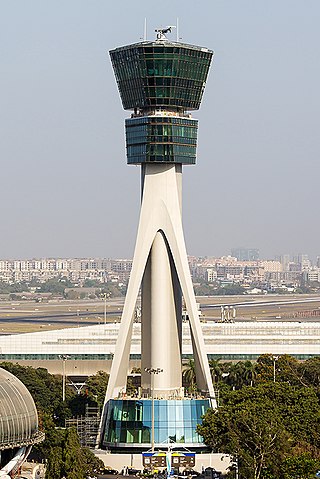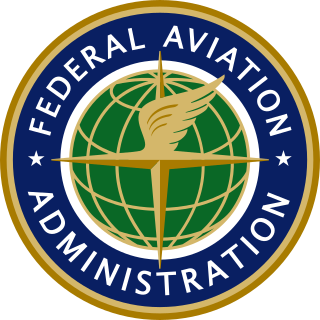
Air traffic control (ATC) is a service provided by ground-based air traffic controllers who direct aircraft on the ground and through a given section of controlled airspace, and can provide advisory services to aircraft in non-controlled airspace. The primary purpose of ATC is to prevent collisions, organize and expedite the flow of traffic in the air, and provide information and other support for pilots.

The Airbus A310 is a wide-body aircraft, designed and manufactured by Airbus Industrie GIE, then a consortium of European aerospace manufacturers. Airbus had identified a demand for an aircraft smaller than the A300, the first twin-jet wide-body. On 7 July 1978, the A310 was launched with orders from Swissair and Lufthansa. On 3 April 1982, the first prototype conducted its maiden flight, and the A310 received its type certificate on 11 March 1983.
Canadian Airlines International Ltd. was a major Canadian airline that operated from 1987 until 2001. The airline was Canada's second largest airline after Air Canada, carrying more than 11.9 million passengers to over 160 destinations in 17 countries on five continents at its height in 1996. Canadian Airlines served 105 destinations in Canada, more than any other airline. It was a founding member of the Oneworld airline alliance.

Edmonton International Airport, officially branded YEG Edmonton International Airport since 2022, is the primary air passenger and air cargo facility in the Edmonton Metropolitan Region of the Canadian province of Alberta. Designated as an international airport by Transport Canada and operated by Edmonton Airports, it is located 14 nautical miles south southwest of Downtown Edmonton in Leduc County on Highway 2 opposite of the city of Leduc. The airport offers scheduled non-stop flights to major cities in Canada, the United States, Mexico, the Caribbean, Central America and Europe.

Wardair Canada was a privately run Canadian airline, founded by Max Ward in 1952 under the name Wardair Ltd, before formally changing its name to "Wardair Canada" in 1976. The airline was acquired by and merged into Canadian Airlines in 1989.
Nepal Airlines Corporation, formerly known as Royal Nepal Airlines, is the flag carrier of Nepal. Founded in 1958, it is the oldest airline of the country. Out of its main base at Tribhuvan International Airport, Kathmandu, the airline operates domestic services within Nepal and medium-haul services in Asia. The airline's first aircraft was a Douglas DC-3, used to serve domestic routes and a handful of destinations in India. The airline acquired its first jet aircraft, Boeing 727s, in 1972. As of February 2023, the airline operates a fleet of six aircraft. Since 2013, the airline has been on the list of air carriers banned in the European Union.
Aeronautical Radio, Incorporated (ARINC), established in 1929, was a major provider of transport communications and systems engineering solutions for eight industries: aviation, airports, defense, government, healthcare, networks, security, and transportation. ARINC had installed computer data networks in police cars and railroad cars and also maintains the standards for line-replaceable units.

École nationale de l'aviation civile is one of 205 colleges accredited to award engineering degrees in France. ENAC is designated as a grande école by the Conférence des Grandes écoles (CGE), a non-profit organisation which certifies and monitors grandes écoles. ENAC was founded on 28 August 1949 to provide initial and continuing education in the field of civil aviation. The school is an établissement public à caractère scientifique, culturel et professionnel, and operates under the oversight of the Ministry of Ecological Transition. Affiliated with the University of Toulouse and Aerospace Valley, it is one of the five founders of France AEROTECH.

In aviation, ACARS is a digital datalink system for transmission of short messages between aircraft and ground stations via airband radio or satellite. The protocol was designed by ARINC and deployed in 1978, using the Telex format. More ACARS radio stations were added subsequently by SITA.

A flight management system (FMS) is a fundamental component of a modern airliner's avionics. An FMS is a specialized computer system that automates a wide variety of in-flight tasks, reducing the workload on the flight crew to the point that modern civilian aircraft no longer carry flight engineers or navigators. A primary function is in-flight management of the flight plan. Using various sensors (such as GPS and INS often backed up by radio navigation) to determine the aircraft's position, the FMS can guide the aircraft along the flight plan. From the cockpit, the FMS is normally controlled through a Control Display Unit (CDU) which incorporates a small screen and keyboard or touchscreen. The FMS sends the flight plan for display to the Electronic Flight Instrument System (EFIS), Navigation Display (ND), or Multifunction Display (MFD). The FMS can be summarised as being a dual system consisting of the Flight Management Computer (FMC), CDU and a cross talk bus.
Jeppesen is an American company offering navigational information, operations planning tools, flight planning products and software. Jeppesen's aeronautical navigation charts are often called "Jepp charts" or simply "Jepps" by pilots, due to the charts' popularity. This popularity extends to electronic charts, which are increasingly favored over paper charts by pilots and mariners as mobile computing devices, electronic flight bags, integrated electronic bridge systems and other display devices become more common and readily available.

An electronic flight bag (EFB) is an electronic information management device that helps flight crews perform flight management tasks more easily and efficiently with less paper providing the reference material often found in the pilot's carry-on flight bag, including the flight-crew operating manual, navigational charts, etc. In addition, the EFB can host purpose-built software applications to automate other functions normally conducted by hand, such as take-off performance calculations. The EFB gets its name from the traditional pilot's flight bag, which is typically a heavy documents bag that pilots carry to the cockpit.
The Future Air Navigation System (FANS) is an avionics system which provides direct data link communication between the pilot and the air traffic controller. The communications include air traffic control clearances, pilot requests and position reporting. In the FANS-B equipped Airbus A320 family aircraft, an Air Traffic Services Unit (ATSU) and a VHF Data Link radio (VDR3) in the avionics rack and two data link control and display units (DCDUs) in the cockpit enable the flight crew to read and answer the controller–pilot data link communications (CPDLC) messages received from the ground.
The Next Generation Air Transportation System (NextGen) is an ongoing United States Federal Aviation Administration (FAA) project to modernize the National Airspace System (NAS). The FAA began work on NextGen improvements in 2007 and plans to finish the final implementation segment by 2030. The goals of the modernization include using new technologies and procedures to increase the safety, efficiency, capacity, access, flexibility, predictability, and resilience of the NAS while reducing the environmental impact of aviation.
Air Philippines Corporation, operating as PAL Express and formerly branded as Air Philippines and Airphil Express, is a wholly-owned subsidiary airline of Philippine Airlines. It is PAL's regional brand, with services from its hubs in Manila, Clark, Cebu, and Davao.

The Air Traffic Organization (ATO) is an air navigation service provider in the United States of America. The ATO is the operational division of the Federal Aviation Administration (FAA).
Airbus ProSky was an Airbus subsidiary dedicated to improving the performance of global air traffic management (ATM) prior to Airbus merging it with Airbus LUCEM and NAVTECH to form Navblue. Composed of ATM experts and offering various solutions to enhance air traffic capacity, efficiency and safety, Airbus ProSky works with air navigation service providers (ANSP), aircraft operators, airport authorities and Civil Aviation Authorities.

Asiana Airlines Flight 162 was a regular short-haul international passenger flight from Incheon International Airport near Seoul, South Korea, to Hiroshima Airport in Hiroshima, Japan. On 14 April 2015, the Airbus A320-232 aircraft touched down short of the runway, struck the localizer array, skidded onto the runway on its tail, and spun 120 degrees before finally coming to a rest on the grass, opposite the terminal building. The aircraft suffered substantial damage to the left wing and engine. Of the 82 people aboard, 27 were injured, one seriously.

Civil aviation in India, the world's third-largest civil aviation market as of 2020, traces its origin back to 1911, when the first commercial civil aviation flight took off from a polo ground in Allahabad carrying mail across the Yamuna river to Naini.
This is a list of aviation-related events in 2023.











